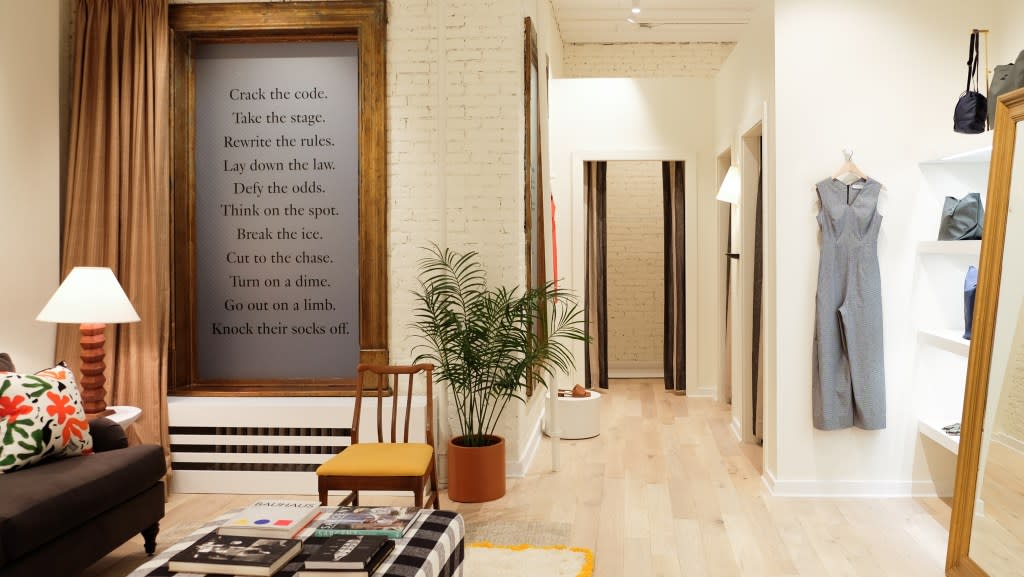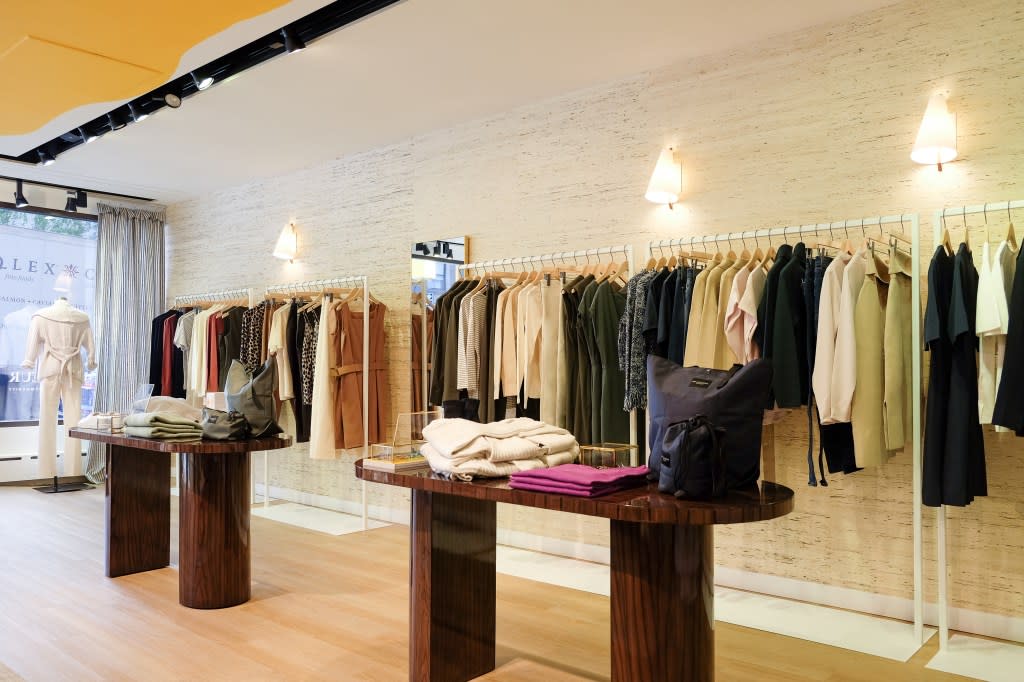How the CEO of a women’s wear brand reinvented the ‘new professional’ dress code dominating the workplace
“Crack the code. Take the stage. Rewrite the rules.”
The inspirational words run across the wall of M.M.LaFleur’s Upper West Side retail store, overlooking light-wash wood floors, a warm lamplit couch, and coffee table (replete with reading material), and, of course, the women’s wear brand’s latest collection of wrap dresses and twill pants. They’re also the beginning of the motto that graced the interior of the “Bento Box” that put M.M.LaFleur on the professional working woman’s fashion map.
Founder and CEO Sarah LaFleur launched the company in 2013, hoping to reach the busy female who struggles to present herself in a certain way and earn credibility among her peers. “Clothing was a really, really powerful way of not just getting other people to see you in that light but also you yourself,” she tells Fortune. “That feeling of putting on a certain outfit—you’re unstoppable. That’s a lot of what I’ve wanted to deliver.”
In 2014, she rolled out what many online retail startups geared toward millennials did at the time—a subscription service. The “Bento Box” aimed to act as a professional shopper for the busy woman on-the-go, featuring five coordinated pieces tailored to each customer based on a questionnaire they filled out. While it’s since been discontinued, it helped M.M.LaFleur finally take off—by 2016, the company was pacing to bring in $30 million in revenue, and it began opening brick-and-mortar locations from New York to San Francisco.

But the pandemic, as it did with many businesses, proved to be a rough ride for a brand that catered to the professional woman, who was now working from her couch in her loungewear. The company implemented layoffs (twice), and shut down stores. Sales fell by more than 50% in 2020, a company representative tells Fortune.
But the brand has eased its way back on its 10-year anniversary. The company claims it grew significantly in the past fiscal year, but declined to provide specific figures as it’s privately held. It’s targeting 35% growth this year, it said. LaFleur says it was an “existential moment” for the company. After a brief, unsuccessful foray into sweatpants taught her a formative business lesson—“stick to the things you know”—she found her way back with a mix of relaxed offerings and classic business wear, a “mullet dressing” concept, as she puts it, that has invaded the workplace.
Pivoting and partnering to execute on a vision
LaFleur was in her mid-twenties when she felt a “big shift” as a Bain & Co. consultant: After years of feeling insecure, she was finally sensing her strengths, giving her the confidence to pursue entrepreneurship. She quit at age 28, launching her label two years later with her own money (she later raised a friends-and-family round).
But LaFleur, now 39, had no prior curiosity about fashion design, intrigued more by leadership and empowerment. She only really cared about presenting herself professionally and earning credibility—fashion was just a method for doing that. She didn’t feel powerful in the “poorly tailored, ill-fitting clothes” she used to wear, she wrote for M-Dash, M.M.LaFleur’s online magazine, adding that the real impetus for starting her brand was to “eradicate ill-fitting suits once and for all and create a line of beautiful, yet professional dresses.”
Luck would have it that a headhunter introduced her to Miyako Nakamura, who studied fashion design in college and worked freelance with designers like Zac Posen and Jason Wu. “Sarah had a finance background and didn’t know many people in the [fashion] industry,” Nakamura told Marie Claire in 2020. “I remember the headhunter saying, ‘You’re going to really love this woman, and you guys will hit it off.’”
She quickly became the counterpart that LaFleur needed as the brand’s cofounder and chief creative officer, making her the “mastermind” of its aesthetics, tailoring, and presentation—with a focus on office functionality over high-fashion artistry. “[Miyako] thinks of fashion as an art form; I think of it as a means to an end, as a tool,” LaFleur says.
At the time, few fabric houses wanted to work with young fashion businesses, so the duo leaned on Nakamura’s industry connections. In the summer of 2012, they tested the market with a pre-launch collection they called “seven perfect dresses for the workplace.” By December of that year, they were off to the races, selling their first collection of 10 dresses directly to consumers.
In the years since, they’ve evolved from their Bento Box subscription service, which was discontinued in 2019, to monthly curated capsules, each one replete with an “inspiring woman” community partner. Their pieces average $325 per item, and range from WonderTex dresses (made from recycled water bottles) to sharkskin skirts. In February 2020, its earnings were its highest ever, LaFleur told Axios. Then came the hard part.
Rebuilding off of ‘power casual’
When the pandemic hit, and work wear became the last thing on anyone’s mind, LaFleur and Nakamura—along with their whole industry—were at a standstill. In the dark, pre-vaccine days of 2020, McKinsey predicted the entire fashion industry’s profits would decline 93% year over year, sweatpants sales be damned.
M.M.LaFleur cobbled together a small investing round in June 2020. But things remained dicey; LaFleur had to close every store and showroom and lay off all store workers. The year 2021 saw similarly depressed sales, which meant more layoffs—and a more dire reconsideration of the brand’s meaning and value.
“I was trying to think about, what is the purpose of M.M.LaFleur, and will it flourish if what we were doing was primarily dressing women who went to the office,” recalls LaFleur, who was trying to reinvent the brand identity she’d honed while also caring for three new babies. “We really came to realize our business isn’t about creating professional clothing. Our business is about dressing.”
“Women who work are our customers,” she adds. “So our clothing might change, our products might change, but our customer doesn’t.”
Once vaccines became widely available, consumers returned to the racks in droves. In March 2022, shopping app LTK saw 166% growth in total monthly searches for office wear compared with October 2020, a company spokesperson previously told Fortune. But shoppers had changed how they dress. Business casual fell from 42% to 37% from 2020 to 2022, per NPD Group, losing share to “casual” dress for work, which grew from 32% to 40% and is defined by items like jeans and sneakers.

A hybrid wardrobe was taking shape, and LaFleur found a way by coining the dress code that’s been steadily emerging as “power casual”—think slacks coupled with a tee. She believes it’s the “new professional” dress code, which she defined as one level above very casual and one level below business casual—catering to the customers unsure of how to dress properly after switching jobs or seeing their workplace become more casual during the pandemic.
An important signifier of the look is its versatility. “If you throw on a jacket, you suddenly look like you’re ready for business, but if you take it off, then you might be ready to play with your kids or go grab a drink with your girlfriend,” LaFleur explains, acknowledging that some companies are still very much in the business formal or business casual camp.
What’s next to bloom
Seizing on power casual—and LaFleur’s willingness to leave her earlier expectations and assumptions by the wayside—has proved to be the brand’s key to recovery. By late 2022, the brand had regained 89% of its pre-pandemic revenue, Axios reported. The company reopened some of its shuttered stores and is launching new ones, having opened its first hybrid store location in Chicago and set to open another in Boston by year-end (for a total of four stores and six locations overall, including showrooms).
The brand also just announced a partnership with the New York Liberty WNBA team and is planning a road show that will hit each retail store throughout the fall. Also on the horizon: expanding her efforts toward carbon neutrality; donating 10% of yearly profits to organizations promoting women’s success; and, by year-end, rolling out a comprehensive living wage program.
It’s a lot to ask of a company that LaFleur feared would go out of business during the pandemic. But, armed with the hard lessons she’s stomached, she’s undaunted by the challenge. It’s that particular openness to maintaining singular focus and turning on a heel that LaFleur recommends to aspiring entrepreneurs (or anyone considering a major pivot).
“The more you can throw yourself into the thing you’re doing right now, the more likely [you’ll] have clarity about whether that’s something you want to be doing, or whether you want to shift gears and go into something else,” she tells Fortune. Her numerous early careers—in consulting, nonprofits, private equity, and finally fashion—have given her the wherewithal to say so with confidence. In each role, she says, she was “always going 120% and really trying to see if that was the thing I want to be doing with my life.”
In her showrooms, at the drawing board, and committing to uncovering what working women will need next, LaFleur has found her answer.
This story was originally featured on Fortune.com
More from Fortune:
5 side hustles where you may earn over $20,000 per year—all while working from home
Want more for your money? These 14 savings accounts have rates of 5% APY (and higher)
Buying a house? Here's how much to save
This is how much money you need to earn annually to comfortably buy a $600,000 home
